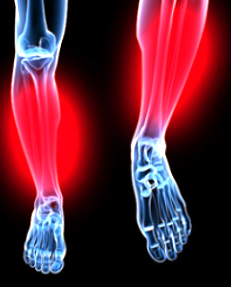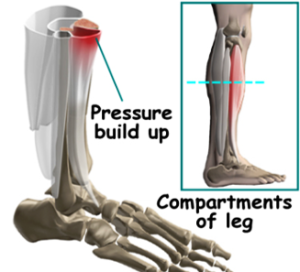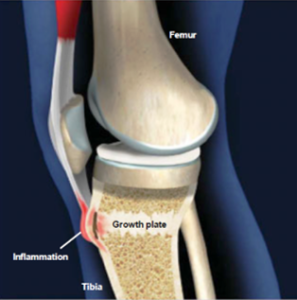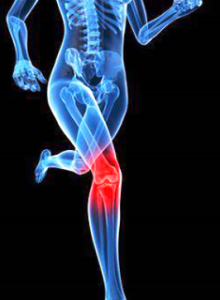Shin Splints
 The vague medical term shin splints has largely been replaced by the more accurate diagnostic term medial tibia stress syndrome (MTSS). Shin splints / MTSS is one of the most common injuries reported by runners and professional athletes.
The vague medical term shin splints has largely been replaced by the more accurate diagnostic term medial tibia stress syndrome (MTSS). Shin splints / MTSS is one of the most common injuries reported by runners and professional athletes.
Shin splints are a painful condition in which there is excessive stress and inflammation on the shinbone (tibia), the thin membrane of the shin bone and surrounding muscles. The common categories where patients normally complain of pain are at the inside of the shinbone (medial) and the front of the shinbone (anterior).
MTSS most commonly starts with tightness, diffuse pain and tenderness along the lower aspect of the front or inside edge of the shinbone (tibia) with physical activity. The symptoms are often worse at the beginning of the exercise and subside with rest but return as soon as the activity is resumed. Progression of untreated MTSS can often lead to stress fracture of the shinbone (tibia).
The problem is common in athletes who perform repetitive activities such as walking as well as activities that involve running and jumping. Shin splints is usually caused by doing too much, too quickly. Patients with shin splints typically report a recent change in training, such as increasing the usual pace, adding distance, or changing running surfaces. People who haven’t run for a while are especially prone to shin splints after they first get started, especially when they run downhill.
The most common causes of shin splints are;
- over exercising and sudden increase in activity
- biomechanical abnormalities
- flat feet (over pronation) – When the foot contacts the ground taking all our weight, it rolls inwards (pronates) to absorb the shock of our body weight. One of the important muscle groups helping to control this motion are the muscles in our shins. When the foot pronates too far or too fast these muscles are overworked and become fatigued and painful.
- High arch feet (supination)
- calf tightness or lower leg muscles
- poor footwear – exercising in shoes with inadequate support and/or cushioning
A detailed assessment assessing training details (running distance, intensity, terrain, frequency, running footwear) and other causative factors will be performed. The aim of shin splint/MTSS treatment treatment is to reduce the amount of the excessive pronation of the foot which will in turn reduce the overworking action of the tibialis posterior muscle which is one of the main causes of shin pain. Orthotics offer excellent shock absorption due to the material used and will restore the foot and its posture to the right biomechanical position.
At Sydney Foot Clinic other treatment modalities offered include;
- rest
- ice
- Non-steroidal anti-inflammatory medication – help reduce the pain and inflammation
- exercises
- muscle stretching
Compartment Syndrome
 Compartment syndrome is a painful condition where excessive pressure builds up in the muscles reducing the blood flow preventing nutrition and oxygen from reaching the nerve and muscle cells. The condition can either be acute or chronic. Acute compartment syndrome is commonly caused by severe injury and is a medical emergency. If left untreated can lead to muscle damage. Chronic compartment syndrome is commonly caused by excessive physical activity and is not usually a medical emergency.
Compartment syndrome is a painful condition where excessive pressure builds up in the muscles reducing the blood flow preventing nutrition and oxygen from reaching the nerve and muscle cells. The condition can either be acute or chronic. Acute compartment syndrome is commonly caused by severe injury and is a medical emergency. If left untreated can lead to muscle damage. Chronic compartment syndrome is commonly caused by excessive physical activity and is not usually a medical emergency.
Some causes of acute compartment syndrome include;
- wearing a tight cast or tight bandage
- crushing injury to the leg
- a fracture or a badly bruised muscle
Some causes of Chronic (exertional) compartment syndrome include;
- pain and swelling caused by exercise
- participating in activities such as running, biking or swimming with repetitive motions
Symptoms of acute compartment syndrome;
- excruciating pain that increases with activity and subsides with rest
- tightness in muscle
- numbness or paralysis
Symptoms of chronic (exertional) compartment syndrome
- numbness and difficulty moving the foot
- pain or cramping during exercise which subsides with rest
- visible muscle bulging
Acute Compartment Syndrome is a medical emergency requiring surgery. Treatment modalities for Chronic Compartment Syndrome include; nonsteroidal anti-inflammatory medications to reduce pain and inflammation and orthotic and physical therapy to correct any underlying problems. It is important that review any activity modifications to reduce symptoms including altering the running or playing surface
KNEE PAIN
Osgood-Schlatter Disease (Children Knee pain)
 Osgood Schlatters disease causes inflammation to either the bone, cartilage and/or the tendon at the top of the shin bone, which is where the tendons of the kneecap is attached. This is a common cause of knee pain in children usually between the ages of 10 to 15 years old or young athletes. It usually occurs due to a period of rapid growth, combined with high level of physical activity and is more an over use injury than a disease. Osgood-Schlatter Disease usually clears up when children stop growing and their tendons are stronger but in some cases it can persist into adulthood.
Osgood Schlatters disease causes inflammation to either the bone, cartilage and/or the tendon at the top of the shin bone, which is where the tendons of the kneecap is attached. This is a common cause of knee pain in children usually between the ages of 10 to 15 years old or young athletes. It usually occurs due to a period of rapid growth, combined with high level of physical activity and is more an over use injury than a disease. Osgood-Schlatter Disease usually clears up when children stop growing and their tendons are stronger but in some cases it can persist into adulthood.
Symptoms
- Pain that gets worse with physical activity and relief from pain with rest
- Tenderness or swelling under the knee or over the shinbone.
- Limping after physical activity
- Tightness of the hamstring or quadriceps
Treatment
Treatment of Osgood Schlatters disease is usually done conservatively. At Sydney Foot Clinic such treatments include;
- Rest – It is important to rest and only do as much physical activity without causing pain to the affected leg.
- Avoid weight bearing exercises ad jumping, squatting and running.
- Ice the affected knee particularly after exercising. Ice should be applied three times a day for up to 10-15 minutes.
- Non-steroidal anti-inflammatory medication (NSAIDs) – help reduce the pain and inflammation
- Exercise program – stretching the quadriceps muscles gently will help with loosening the music tendons.
- Custom made orthotic therapy – address any biomechanical factors that that could be contributing to the disease
- Often the knee function is a result of the way the foot functions. A pronated foot (flat feet) caused the lower leg to rotate slightly inward. This causes the patellar tendon to pull in an abnormal direction where it attaches in the front of the knee. Orthotics can help reduce this irritation/damage and help to treat the problem
It is important to talk to your podiatrist about managing the condition and the importance of not over training during the healing process.
Patella femoral pain syndrome (Runner’s Knee)
 Patellofemoral pain (patellofemoral pain syndrome) refers to the pain that is felt at the front and around of the patella (kneecap). Patients most commonly report a dull ache at the patella region that is increased with running, squatting, jumping, stair climbing or activities that involve knee flexion. Pain can be typically worse with activity or sitting for long periods of time with grinding feeling or noise felt when the knee moves (crepitus).
Patellofemoral pain (patellofemoral pain syndrome) refers to the pain that is felt at the front and around of the patella (kneecap). Patients most commonly report a dull ache at the patella region that is increased with running, squatting, jumping, stair climbing or activities that involve knee flexion. Pain can be typically worse with activity or sitting for long periods of time with grinding feeling or noise felt when the knee moves (crepitus).
Poor biomechanics, is the major cause of patellofemoral injury. The most common mechanical problem is over pronation (flat feet). Over pronation increasing frictional stress under the patella causing inflammation. This occurs because the patella is not running smoothly within the femoral groove at the angle at the knee (called the Q angle) is increased. This is far more common in women runners as due to the hip anatomy female athletes have an increased Q angle. Other causes of patellofemoral injury include;
- Muscle imbalance (Tight muscles groups) – If posterior muscles such as calf muscles and hamstrings are tight extra, stress is placed on the knee as it does not fully extend through the gait cycle. Additionally weak muscles not providing stability to the knee can also lead to this injury.
- Increased frequency (how often you exercise), duration (how long you exercise) and intensity (your level of exercise).
- Running style and running on hard or uneven surfaces.
- Worn footwear is also a major contributory factor. If the shoe is not doing its job of providing both stability and shock absorbency then ground reaction force will be transferred to the knee increasing the chances of patellofemoral problems occurring.
Treatment
The podiatrist will obtain a comprehensive history of symptoms and perform a biomechanical assessment identifying the cause of the pain. Diagnostic imaging including an X-ray and Ultrasound may be prescribed by the podiatrist for further review of the painful area. At Sydney Foot Clinic some conservative treatment modalities include;
- Rest – avoid activities that worsen the symptoms (squatting, jumping, bending the knee)
- Ice and Nonsteroidal Anti-inflammatory drugs (NSAIDS) – this will help reduce the pain and inflammation
- Footwear recommendations
- Training modifications
- Custom orthotic therapy – orthotics may be prescribed to address any biomechanical factors such as over pronation (flat feet)
